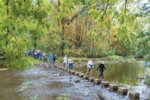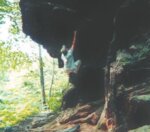The Wissahickon offers countless opportunities for outdoor recreational activities like birding, hiking, trail biking, horseback riding and rock climbing.
This item is available in full to subscribers.
We have recently launched a new and improved website. To continue reading, you will need to either log into your subscriber account, or purchase a new subscription.
If you are a digital subscriber with an active subscription, then you already have an account here. Just reset your password if you've not yet logged in to your account on this new site.
If you are a current print subscriber, you can set up a free website account by clicking here.
Otherwise, click here to view your options for subscribing.
Please log in to continue |




A group of birders gathers for an early morning walk along Forbidden Drive in Wissahickon Valley Park on a chilly, overcast day in January. Except for the chatter of mallard ducks paddling in nearby Wissahickon Creek – occasionally dipping their heads underwater in search of bugs and snails – it’s still and quiet.
The group starts walking toward the dam near the Valley Green Inn, hoping to spot a brightly colored wood duck, often found in hollowed-out parts of trees. Blue jays and cardinals fly overhead among the bare branches.
Suddenly the silence is broken by a sharp, metallic sound followed by a musical trill. Troy Bynum, a wildlife photographer and co-leader of the walk sponsored by the Mt. Airy Learning Tree, can barely contain his excitement as he turns toward the underbrush that lines Forbidden Drive and spots a rufous-sided towhee.
“Towhees are normally very skittish, so it’s pretty special to see one,” says Bynum, who as a child growing up in Mt. Airy used to feed the ducks in the park with his parents. During the Covid 19 pandemic, he often hiked in the park, which led to his interest in wildlife photography.
Bynum, resident birder and program director for the Whitemarsh Foundation at Dixon Meadow Preserve, is one of about 2 million people who use the park annually. Known as the Wissahickon, or simply ‘the Wiss’ by locals, the park offers countless opportunities for outdoor recreational activities that include not only birding but also hiking, trail biking, horseback riding and rock climbing, among others. All of this within the confines of the bustling city of Philadelphia.
Located in the northwest part of the city, the Wissahickon encompasses more than 2,000 acres of streams, dense forests and rugged trails. Situated between Montgomery County and the Schuylkill River, the park has approximately 50 miles of wooded trails that wind through a deep gorge surrounding the creek that gives the park its name.
Erika Wallace, 53, a Chestnut Hill resident who bikes on the trails, says she is “overwhelmed by the juxtaposition” of the park and the city that surrounds it. “The presence of this beautiful wilderness, which serves a diverse population in a big city with rough and gritty parts to it, is amazing to me.”
Wallace says she was drawn to the Wissahickon after moving to Chestnut Hill from Atlanta, where she had to drive everywhere. When she realized that she could bike from her home to the Wissahickon in minutes, she was hooked on the park. These days, she usually bikes on the trails four mornings a week before going to work.
“To me, there’s something unifying about the Wissahickon,” says Wallace. “We live in a big city, but the park brings us together. We have something in common. We all set our alarm clocks to get out into the woods in the morning.”
Wallace, the office manager for a social services agency in Germantown that helps older adults stay in their homes, says starting her morning in the Wissahickon “feeds me throughout the day.” On her way home from the park, she usually stops on the Rex Avenue Bridge, which crosses Wissahickon Creek, to take in the beauty and silence around her. “You can’t hear the noises of the city from there,” she says.
At the end of a work day, she takes Henry Avenue through Roxborough, picturing the trail that runs alongside it and looking forward to her ride in the morning.
For Wallace, who tends to ride solo on the trails, the park is something akin to church. “The Wissahickon has a spiritual quality to it,” she says. “It’s my parish.”
‘Experiencing the park at different speeds’
For those who like to run on the trails with others, there are groups that sponsor practice runs and races in the park. One of the oldest and largest is the Wissahickon Wanderers, which was established about 20 years ago. The group is free and open to runners of all ability levels.
Dan McGinnis and his wife, who live in Glenside, started running with the group about 10 years ago. Before joining the Wanderers, McGinnis typically ran on Forbidden Drive, with its relatively flat and even terrain. After watching other runners head for steeper trails, McGinnis decided to give it a try.
“I love experiencing the park at different speeds,” says McGinnis, a software engineer who also bikes the trails. “Every experience in the park is different because the trails vary so much. I see all sorts of nature whether I’m riding along the creek, in a pine forest or a meadow. It’s always a joy.”
The Wanderers sponsor Thursday evening and Saturday morning practice runs, which start at the Valley Green Inn. Members of the group range from those who have never run before to others who have competed in ultramarathons in locales around the world, says McGinnis.
“Our mission is about promoting camaraderie and enjoying the park,” he says. “Whether you’re training for a race, running at your own pace or walking, we welcome you to the Wanderers.”
The group sponsors several free races annually, including its Spring and Fall Trail Series and the Wissahickon Trail Classic 10K. One of Philly’s premier races, the Trail Classic 10K will be held on June 1 this year.
The race, which always takes place on National Trails Day, was established in 2006 by the Wanderers to highlight the park as one of the best trail-running destinations on the East Coast. The 2024 race and a 1-mile, family-friendly nature walk start and end at The Cedars House restaurant on West Northwestern Avenue at Forbidden Drive.
Running the trails and building community
Gary Brown Jr., founder and leader of the running group Chasing Trail, describes managing the group as “a labor of love.”
Brown, who grew up in South Philadelphia, bought his house near the Wissahickon Creek Trailhead in Roxborough 15 years ago because of its proximity to the park. Last January, he watched from his home, which sits about the length of a football field from the Wissahickon, as snow blanketed the park. Eager to run in the snow, he checked the weather forecast, trying to figure out the best time to head outside.
A passionate advocate for the Wissahickon, Brown started Chasing Trail about 10 years ago, as a way of encouraging people to come together as a community, no matter their running ability or experience. The group’s motto is “All paces, all faces.”
“Because of the times we live in, building community is really important to me,” says Brown. “Getting together and talking to each other is the first step in accepting people for who they are.”
Chasing Trail hosts Sunday morning runs that start at the Valley Green Inn as well as pop-up runs to celebrate the holidays, including Christmas, Halloween, Thanksgiving and St. Patrick’s Day. For its Very Merry Wissmas run last December, the group hung brightly colored balls from trees and decorated the stone in the park that commemorates the first baptism of the Church of the Brethren in America with tiny lights and shiny garland.
On runs with the group, Brown is often the last person in line, making sure that no one gets lost in the woods. “Every single time I’ve gone to the Wissahickon, it’s been different. How magical is that?”
Bouldering for exercise and well-being
Ben Kincaid, who likes to boulder in the Wissahickon, says the sport is “kind of like a video game that you play with your body.” Bouldering – a form of rock climbing on lower outcroppings – involves solving puzzles or short “problems” to scale rocks in a particular way.
Kincaid, an applications engineer for a start-up that provides design and software expertise for nonprofits and government agency staff, likes the simplicity of the sport. Bouldering requires little more than a good pair of climbing shoes, a chalk bag and a couple of crash pads, which are similar to gym mats.
For those who prefer rock climbing, which involves ropes, harnesses and anchors, the Livezey Rock area has long been a popular spot. The area comprises several huge boulders of Wissahickon Schist – the result of blasting by a Civilian Conservation Corps crew in the 1930s to build a sewer pipe that runs past the rocks.
Kincaid, 38, discovered the Wissahickon after moving to Philadelphia in 2009 to take a job with Americorps. He was surprised by the similarities between parts of the park and the Appalachian Mountains in his native North Carolina. Now, depending on the weather, he boulders in the Wissahickon about once a week, either at Revolutionary Ridge, which is across the creek from the Forbidden Drive parking lot, or the 100 Steps Boulders off Lincoln Drive near Ridge Avenue.
“I like the collaborative aspect of bouldering,” says Kincaid, who lives in South Philadelphia. Climbers typically work in small groups, taking turns on a rock and making sure that crash pads are in the right spot in the event of a fall.
“On a nice day, there’s nothing better than bouldering and then hanging out on a rock, basking in the sun,” says Kincaid. “It’s endeared me to the park and it’s great for my sense of well-being.”
Reflecting on poetry and nature
Fields of dry goldenrod surround a trail that winds through the Wissahickon’s Andorra Meadow. A hiker reads a poem by American poet Mary Oliver, whose prize-winning work was inspired by her love of nature.
The hiker is part of a group led by Lisa Kleiman and Jean McWilliams, trail ambassadors for the Friends of the Wissahickon. The group is on the Yellow Trail on a mild, sunny afternoon in February, stopping periodically while someone reads a poem by Oliver. In between readings, the participants – most of whom have never met before – get to know each other, chatting about their work, their children and grandchildren, and what brought them to the park.
Kleiman, a retired information technology professional who set up the route for the walk, describes the experience “as a great equalizer” that sometimes prompts participants “to open up and share their feelings.” McWilliams, a retired English teacher who came up with the idea of incorporating Oliver’s poetry into the walk, says it’s “kind of a spiritual experience” for her.
Inspired by Oliver’s writing, Amee Shah, a poet and health sciences professor who teaches at New Jersey’s Stockton University, stops and shares a poem that she’s written while on the trail. Part of it reads:
Bluebird boxes in Andorra meadow,
Now empty of their residents
Sweet gentle, where are they now?
“I think reading Mary Oliver’s poetry in nature is so powerful and moving,” says McWilliams, who has collaborated with Kleiman on other walks since they met during their trail ambassador training in 2022. “It sparks camaraderie and prompts moments in nature that can be very illuminating.”